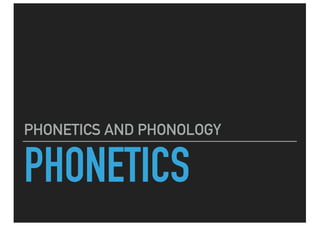This document discusses the speech production mechanism. It describes the four main components: the airstream process using the lungs, the phonation process using the vocal folds, the oro-nasal process determining if air exits through the mouth or nose, and the articulatory process using the tongue and lips. It also outlines the principal parts of the upper and lower vocal tract that are used in speech articulation.



![CHAPTER 1 ARTICULATION AND ACOUSTICS
The air passages above the larynx are known as the vocal tract.
Figure 1.1 shows their location within the head (actually, within Peter
Ladefoged’s head, in a photograph taken many years ago). The
shape of the vocal tract is a very important factor in the production of
speech, and we will often refer to a diagram of the kind that has
been superimposed on the photograph in Figure 1.1. Learn to draw
the vocal tract by tracing the diagram in this figure. Note that the air
passages that make up the vocal tract may be divided into the oral
tract, within the mouth and pharynx, and the nasal tract, within the
nose. When the flap at the back of the mouth is lowered (as it
probably is for you now, if you are breathing with your mouth shut),
air goes in and out through the nose. Speech sounds such as [ m ]
and [ n ] are produced with the vocal folds vibrating and air going out
through the nose. The upper limit of the nasal tract has been marked
with a dotted line since the exact boundaries of the air passages
within the nose depend on soft tissues of variable size.](https://image.slidesharecdn.com/chaper2phoneticsstudent-211124064231/85/Chapter-2-phonetics-student-pptx-4-320.jpg)

![CHAPTER 1 ARTICULATION AND ACOUSTICS
The parts of the vocal tract that can be used to form sounds,
such as the tongue and the lips, are called articulators. Before we
discuss them, let’s summarize the speech production mechanism as
a whole. Figure 1.2 shows the four main components—the airstream
process, the phonation process, the oro-nasal process, and the
articulatory process. The airstream process includes all the ways of
pushing air out (and, as we will see later, of sucking it in) that provide
the power for speech. For the moment, we have considered just the
respiratory system, the lungs pushing out air, as the prime mover in
this process. The phonation process is the name given to the actions
of the vocal folds. Only two possibilities have been mentioned:
voiced sounds in which the vocal folds are vibrating and voiceless
sounds in which they are apart. The possibility of the airstream going
out through the mouth, as in [ v ] or [ z ], or the nose, as in [ m ] and [
n ], is determined by the oro-nasal process. The movements of the
tongue and lips interacting with the roof of the mouth and the
pharynx are part of the articulatory process.](https://image.slidesharecdn.com/chaper2phoneticsstudent-211124064231/85/Chapter-2-phonetics-student-pptx-6-320.jpg)




